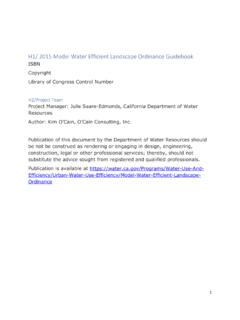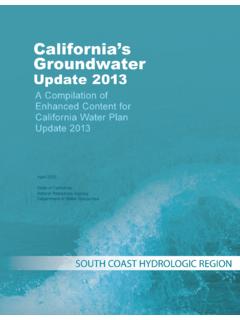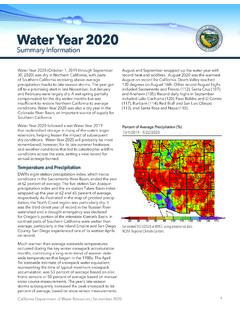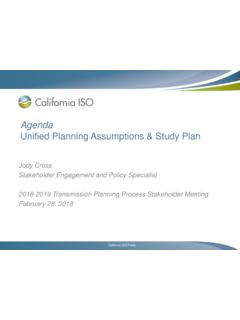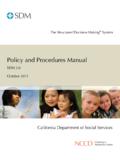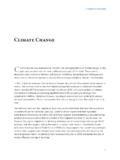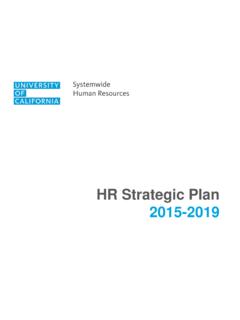Transcription of Guidance Document for Groundwater Sustainability …
1 Guidance Document for Groundwater Sustainability PlanStakeholder Communication and EngagementCalifornia Department of Water ResourcesSustainable Groundwater Management ProgramJanuary 2018 Guidance Document for Groundwater Sustainability PlanStakeholder Communication and EngagementJanuary 2018 The objective of this Guidance Document is to provide Groundwater Sustainability Agencies (GSAs) information to aid with stakeholder communication and engagement for Groundwater Sustainability plan (GSP) preparation. It provides examples and existing resources related to public engagement and effective communication for Sustainable Groundwater Management Act (SGMA) and use of this Guidance informationThis Guidance Document is not intended to prescribe specific outreach and communications methods for GSAs or local agencies to follow, but to provide resources and various examples for consideration.
2 This Guidance Document also summarizes the public notification requirements that GSAs must adhere to in order to comply with SGMA and the GSP regulations. Other than what is required by statute or regulation, GSAs have discretion on how they communicate and engage with the beneficial uses and users of Groundwater within a Department of Water ResourcesSustainable Groundwater Management Program1416 Ninth Box 942836 Sacramento, CA 1: Overview ..1 Section 2: About Public Engagement ..3 Section 3: Planning Communication & Engagement ..5 Section 4: Engagement Methods & Tools ..14 Section 5: Additional Resources ..15 DWR Region OfficesThe california Department of Water Resources (DWR) provides a variety of SGMA-related resources to assist water management groups and the public. Four DWR Region Offices are strategically located across the state.
3 All high and medium priority basins are assigned a Point of Contact from DWR Region Offices. POCs assist GSAs and stakeholders in the basin to connect with the Sustainable Groundwater Management Program and locate resources for assistance. POC contacts can be found on DWR website All regions can be reached via email at Stakeholder Communication and Engagement Guidance DocumentCalifornia Department of Water Resources1 Section 1 OverviewThe legislative intent of the historic 2014 Sustainable Groundwater Management Act (SGMA) is for Groundwater to be managed sustainably in california s Groundwater basins by local public agencies and newly-formed Groundwater Sustainability Agencies (GSAs).In the basins designated by the Department of Water Resources (DWR) as medium and high priority, local public agencies and GSAs are required to develop and implement Groundwater Sustainability plans (GSPs) or alternatives to GSPs (Alternatives).
4 Under the requirements of SGMA, GSAs must consider interests of all beneficial uses and users of Groundwater . As a result, the GSP development needs to consider effects to other stakeholder groups in or around the Groundwater basin with overlapping interests. These interests include, but are not limited to, holders of overlying Groundwater rights (including agriculture users and domestic well owners), public water systems, local land use planning agencies, environmental users, surface water users, federal government, california Native American tribes, and disadvantaged communities (Water Code ).Furthermore, the GSP Regulations require that GSAs Document in a communication section of the GSP the opportunities for public engagement and active involvement of diverse social, cultural, and eco-nomic elements of the population within the basin.
5 Expertise of stakeholders may increase the chance that the GSAs are using best available information and best available science for GSP GSAs begin to meet to develop a GSP, common questions, such as the ones below, are considered regarding stakeholder communication and can a GSA effectively communicate and engage with multiple and varied stakeholders? This Document helps GSAs determine who the interested parties are (individuals, organizations, local agencies) that they need to engage with and provides Guidance to better understand their issues and interests of beneficial uses and users of Groundwater . What are methods and tools for communications and engagement? This Document provides links to methods and tools that can be modified and used to reach and com-municate with stakeholders. Not all of the tools will be applicable to all GSAs, but they are presented as examples of effective ways to engage.
6 How can a GSA conduct meaningful engagement to develop a GSP? This Document gives GSAs a step-by-step example of how to communicate and engage with stake-holder groups. In addition to following the procedure requirements for public notice, meaningful engagement is to integrate stakeholders throughout the development of a GSP and allow active participation in the decision-making process. The benefits of meaningful engagement are improved outcomes, optimized resources, broad support, and reduced conflict. GSP Stakeholder Communication and Engagement Guidance DocumentCalifornia Department of Water Resources2 Published ResourcesThere are several published documents that either directly or indirectly address best prac-tices or statutory requirements for stakeholder engagement. In addition to the information in this Guidance Document , these documents may be useful for GSAs while developing a Com-munication and Engagement (C&E) plan or other outreach programs.
7 Groundwater Sustainability plan (GSP) Emergency Regulations Guide, california Department of Water ResourcesThis guide (published July 2016) includes information to aid with the understanding of the GSP Regulations. It explains the fundamental concepts of the regulations and contains information directly relevant to the regulations through four general phases of development and implementation. and Engagement: A Resource Management Strategy for the california Water plan , california Department of Water ResourcesThe california Water plan provides a broad set of resource management strategies (RMSs) that can help local agencies and government (and GSAs) manage their water and related resources. While not specific to SGMA, the Outreach and Engagement RMS directly addresses water management in california and discusses tools and practices by water agencies to facilitate contributions by public individuals and groups toward good water management outcomes.
8 For Success: Stakeholder Engagement for Sustainable Groundwater Management Act Implementation, Community Water CenterPrepared by the Community Water Center in July 2015, the intent of this report is to convey the value of stakeholder engagement to sustainable Groundwater management. The report outlines the statutory requirements for stakeholder engagement in SGMA, gives examples of best practices and examples of collaborative management from around the state, and provides a recommended roadmap for effective stakeholder engagement drawn specifically for SGMA implementation. Inclusive Public Engagement, Institute for Local Government (ILG)This report offers tip sheets and resources to effectively and successfully plan and implement successful engagement strategies. Whether it s supporting and connecting with local leadership programs as a pipeline to engage specific populations, or partnering with local community-based organizations to reach beyond the small slice of the public that most frequently attends meetings, ILG s inclusive public engagement resources will offer perspective to any planning process.
9 With Tribal Governments Guidance Document (Draft), california Department of Water ResourcesThis Document is meant to help local agencies engage with a Tribal government in the planning, financing, and management of a GSA, or with development or implementation of a Stakeholder Communication and Engagement Guidance DocumentCalifornia Department of Water Resources3 Section 2 About Public EngagementWhat is Public Engagement?As defined by the Center for Advances in Public Engagement:Public engagement is a process that brings people together to address issues of common importance, to solve shared problems, and to bring about positive social change. Effective public engagement invites citizens to get involved in deliberation, dialogue, and action on public issues that they care about. It helps leaders and decision makers better understand the perspectives, opinions, and concerns of citizens and done well, public engagement goes far beyond the usual participants to include those members of the community whose voices have traditionally been left out of political and policy debates.
10 Build Public Engagement for Regional SustainabilityMany areas have public engagement efforts already in place for other water management efforts such as Integrated Regional Water Management Plans and Groundwater Manage-ment Plans. Use these existing stakeholder connections as you begin your SGMA-related communication and engagement efforts. Collectively, all water management plans work with a shared interest toward the ultimate goal of regional Engagement Benefits Helps people weigh a variety of perspectives and listen to each other s views. Builds common understanding, manages differences, and establishes direction for moving ahead on tough issues. Builds trust and improves communication between the public and leaders. Creates new opportunities for citizens to become involved in public problem solving and decision Stakeholder Communication and Engagement Guidance DocumentCalifornia Department of Water Resources4 Levels of EngagementIt is important that stakeholders understand the role they are invited to play in a public engagement program.
